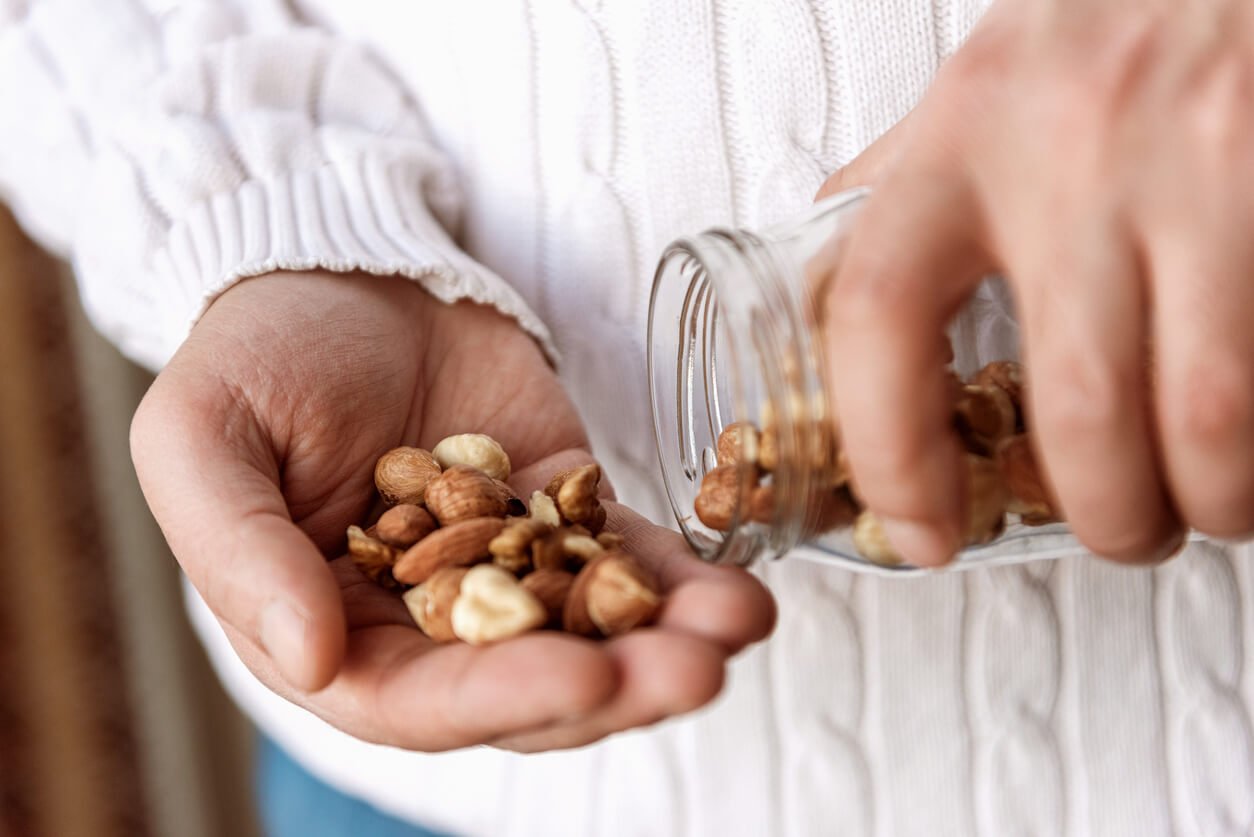Three types of carbohydrates are found in nature: sugar, fiber, and starches.
This means that all starches are carbohydrates, but not all carbohydrates are starches. Sugar, for example, is a simple carbohydrate, while both fiber and starches are complex carbohydrates.This doesn’t mean that all starches act like complex carbohydrates once we subject them to processing, though. Most cookies, white bread, and crackers (for example) typically get digested as rapidly — and spike blood glucose just as dramatically — as simple carbohydrates like table sugar.
But, let’s back up and talk about starches as they appear in the plants that contain them. (Fun fact: You can’t get starch from eating an animal unless you eat the undigested plant matter in that animal’s digestive system, which sounds pretty gross to me.) These starches are natural compounds composed of long, branching chains of glucose (a sugar, and the primary source of energy for living cells). They’re produced in plants to serve as an energy source, helping plants survive when the climate is cold or dry. Starches are also an energy source for humans and other animals who then consume these plants further up the food chain.
When starches are digested, they’re broken down into glucose molecules with the help of digestive enzymes called amylases. (Here’s a joke I’ve been waiting my whole life to share: “What’s the name of the enzyme in saliva that breaks down starch?” “I don’t know, but it’s on the tip of my tongue.”)
Different types of plants contain varying amounts of starch. For instance, plants that can photosynthesize easily thanks to a large leafy surface area and many hours of full sun tend to have less starch than plants that have to save energy for literal and figurative rainy days.
Types of Starches
Starches are made up of two kinds of molecule: amylose and amylopectin, which connect together to form starch granules. These molecules exhibit different characteristics that determine the digestibility of the starches that contain them. There are three types of starches, categorized by their digestibility. Starch-containing foods typically include all three types, in varying amounts. One of the molecules, amylopectin, turns into Rapidly Digestible Starch (RDS). The other, amylose, forms Slowly Digestible Starch (SDS) and Resistant Starch (RS).
Slowly Digestible Starch (SDS)

Around 20–30% of the starch in plant foods is amylose. Amylose is a straight-chain molecule that we digest and absorb slowly, which is why — surprise! — it’s called a slowly digestible starch, or SDS. It can help keep your blood sugar balanced because it does not cause a large spike in blood sugar levels, and is digested slowly throughout the entire length of your small intestine. This process helps provide a sustained release of glucose, with a low initial rise in blood sugar levels followed by a slow and prolonged release (over the course of two hours or so) of insulin. Starchy foods high in amylose rank low on the glycemic index, since they typically trigger a balanced energy release associated with good metabolic health.
You can think of low glycemic metabolism like an experienced driver keeping a steady foot on the accelerator pedal, versus a new driver who pushes too hard so that the vehicle lurches forward as it accelerates — and who may then need to apply the brakes to keep from speeding. Overall, eating SDS foods can help minimize both hyperglycemia after eating and any subsequent hypoglycemic drop.
Health Effects of SDS
As such, this type of starch may be helpful in controlling and preventing hyperglycemia-related diseases, including diabetes, obesity, and heart disease (or metabolic syndromes).
High-SDS foods may also support heart health by improving levels of HDL “good” cholesterol, particularly in women. They have also been shown to help reduce serum total cholesterol, LDL “bad” cholesterol, and free fatty acids in the bloodstream (all of which can increase your risk for heart disease at high levels). In one study, researchers found that five weeks of a low-GI, high-SDS diet helped improve blood fat levels, reduce total fat mass, and increase lean body mass — which is to say, study participants grew more muscle and lost body fat.
Lastly, eating more SDS may promote fat oxidation at the expense of carbohydrate oxidation — in other words, it may help you lose body fat by moving fat to the top of the “which fuel shall we burn next” list.
High amylose foods include legumes, nuts, and seeds.
Rapidly Digestible Starch (RDS)

Approximately 70–80% of the natural starch found in plants is amylopectin, which we tend to digest rapidly. In foods that are very high in rapidly digestible starch (RDS), the glucose units are easily digested when you eat them, which can lead to a quick spike in blood sugar quickly followed by a hunger-producing drop in blood sugar (a phenomenon known as hypoglycemia).
RDS is usually absorbed in your upper small intestine within about 30 minutes. The swift rise and fall in blood sugar levels comes about as your pancreas secretes insulin into your bloodstream to reduce glucose levels as quickly as possible. This large fluctuation in blood glucose generates oxidative stress in the body that can lead to cell, tissue, and organ damage. That inflammation and stress may lead to chronic disease formation — so basically, the opposite of the positive effects seen in SDS. These effects, over time, are particularly dangerous for people with insulin resistance and diabetes.
While SDS is associated with lower-GI foods, RDS is associated with high-GI foods, a category consisting largely of highly processed, or simple, carbohydrates. (For more on the glycemic index, we have an article here.) You’re more likely to find RDS in foods like white breads, breakfast cereals, and commercial baked goods, as well as boiled white rice and processed potato products like instant potatoes and potato chips.
Health Effects of RDS
Long-term consumption of a high-RDS diet can lead to weight gain or obesity.
Making matters worse, RDS doesn’t always ride alone. When foods high in RDS are cooked at high temperatures they can form acrylamide, which is a carcinogen. Some foods that contain higher levels of acrylamide include french fries, potato chips, and processed foods made from grains (such as breakfast cereals and cookies).
My intention here isn’t to demonize amylopectin, which, after all, is naturally found in all starchy foods. It is digested more quickly than amylose, but if it’s part of a food that is also rich in amylose (or if it’s paired with other high-fiber and high-amylose plant foods), your body should be able to absorb it happily without experiencing a negative impact on blood sugar and inflammation.
And, RDS is definitely good for at least one thing: Because you typically experience a glucose spike after eating high-RDS foods, they can be useful for fueling athletic performance. Endurance athletes generally agree that high-RDS foods are useful to keep muscles working during an event or grueling training session, even if they avoid those cookies, PB&J sandwiches, and energy bars the rest of the time. Most research, however, still prioritizes quantity of carbohydrate over type of carbohydrate when it comes to fueling (and recovering from) exercise.
Resistant Starch (RS)

Resistant Starch (RS) is a type of amylose, a fermentable fiber that is not digested. It is, however, fermented by the trillions of bacteria in your colon. This fermentation produces short-chain fatty acids that provide energy to cells in your large intestine and do a whole lot of good pretty much everywhere in your body, as we’re about to see.
The foods highest in resistant starch are whole grains, legumes, potatoes, and green bananas.
Reasons to Eat Resistant Starch

Resistant starch boasts a number of significant health benefits that may help in the prevention of chronic disease. Below are four ways in which resistant starch has been shown to be good for you. As you’ll see, it has plenty of reason to brag.
1. It improves your gut and digestive health.
Undigested carbohydrates, including resistant starch, are prebiotics that ferment and turn into food for the good bacteria in your digestive system. Eating resistant starch boosts the population of these beneficial bugs, which are commonly called probiotics. So fortified, these good critters crowd out the bad ones, making for a happier gut (and a healthier gut owner).
Eating resistant starch helps to heal gut issues while preventing the development of a leaky gut that could otherwise drive food allergies, inflammation, and weight gain.
The positive change that resistant starch brings about in your gut microbiota may even translate to benefits for kidney health. Studies have shown that RS helps those with chronic kidney disease reduce inflammatory and toxic biomarkers in their plasma. RS increases the number of good bacteria, strengthening the epithelial lining and outcompeting bacteria that produce harmful metabolites. Thus, fewer inflammatory agents are able to reach the bloodstream and cause issues for those with compromised kidneys.
2. It improves your insulin sensitivity.
Research shows that in humans, consumption of RS increases insulin sensitivity. This makes sense, as we’ve already seen that its lower digestibility leads to a decreased release of glucose into the bloodstream.
The metabolic benefits of dietary RS, especially in terms of improvements in insulin processing, occur independently of your gut microbiota. In one study, 15–30 grams (about 2–4 tablespoons) of potato starch per day improved insulin sensitivity and fat loss in obese men.
3. It may help prevent obesity.
Some researchers suggest that RS may help to prevent or treat obesity. How? RS is low in digestible calories. Low-caloric-density eating has been shown to be a sustainable approach to weight loss, since dieters may feel less deprived with a higher volume of food.
Furthermore, RS can work on a metabolic level to help reduce fat accumulation through its influence on gut bacteria and lipid metabolism.
4. It helps improve cholesterol levels.
A high cholesterol level and, in particular, a high ratio of LDL “bad” cholesterol to HDL “good” cholesterol, is a risk factor for developing heart disease.
But a 2018 meta-analysis (including 20 trials and published in Nutrition Research) showed that resistant starch was able to lower LDL cholesterol. Researchers found that adding resistant starch to subjects’ diets optimized triglyceride and cholesterol levels while decreasing fat mass. The effects were found to be most prominent when people ate at least 20 grams of RS per day, and did so for at least 4 weeks.






Комментариев нет:
Отправить комментарий